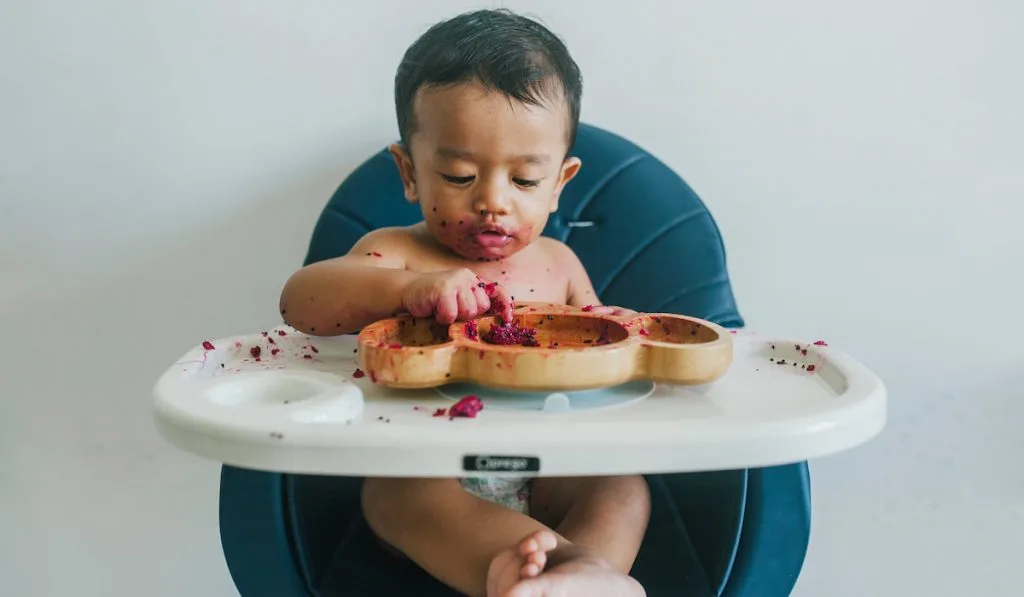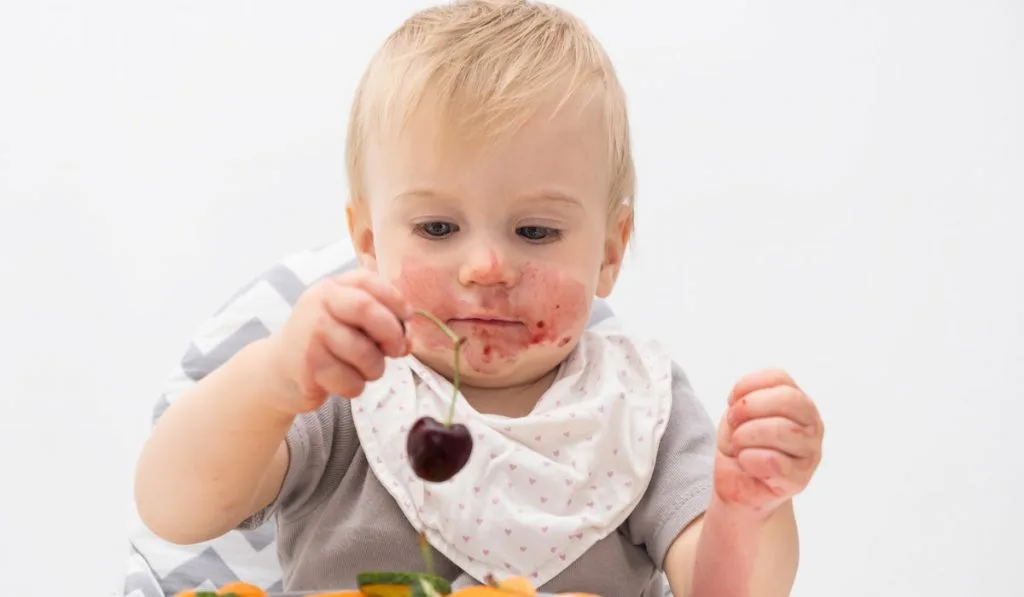Is your baby eating pureed food? If yes, you may be wondering about the best way to start feeding them solid foods. But how can you start baby-led weaning (BLW) after purees?
Is there a safe way to introduce your little munchkin to solids?
The right time to employ baby-led weaning is at around 6 months old, but only if the baby has reached certain developmental milestones. These include being able to sit up without support and showing interest in food by opening their mouth or sticking out the tongue while watching others eat.

Many parents have tried transitioning their babies from eating purees and find it hard. The babies may gag excessively, vomit, or even refuse to eat finger foods. This happens because they only want foods that are easy for them to swallow and eat.
This article discusses how to get started with baby-led weaning after they eat purees. It also highlights some of the advantages of baby-led weaning as well as potential concerns you might have about transitioning your child to this method of eating.
Transitioning Your Child From Purees to Finger Foods
The best way to transition your baby from puree to finger foods is by advancing their purees. If your baby was used to eating smooth purees, make the puree thicker each time with larger lumps. You can do this by:
- Mushing their foods just a little less
- Adding minced pieces in the puree.
Continue serving them this kind of puree until it becomes thicker and coarser. This will help them transition easily to finger foods.
You can then offer the baby steamed sliced foods that they can chew and swallow. Soft foods and vegetables are a great choice to give in the beginning. Introduce firmer foods gradually that they can chew with their bare gums.
If you can easily roll the soft food with your tongue or finger, then it is safe for your little one.
Ensure you offer your infant new foods for them to explore. This will help you know the kind of foods your baby prefers.
If you offer slippery soft foods such as mangoes or avocadoes, roll them in baby cereals, ground flax, or almond so that your baby can have a better grip.
Don’t forget to offer them water at mealtimes in open cups so that they can improve their oral motor skills.
Advantages of Baby-Led Weaning After Puree
The primary advantage to starting baby-led weaning after your baby is used to eating pureed food is that you can introduce solids slowly, making sure that your baby is comfortable with the new way of eating.
Your baby will learn to eat foods that are common to your family’s diet.
The key to success with this type of weaning is to take your time and find a pace that’s comfortable for you and your baby. By allowing them to control the pace of eating and explore different types of foods, you can reduce the risk of choking, so they have time to chew properly when necessary.
You can discuss the risks with your pediatrician before introducing your baby to solids. This way, you can both agree on a plan that allows your baby to explore a variety of foods safely.
There are some simple steps you can take to reduce the risk of this happening.

Benefits to Baby-Led Weaning
Here are some of the benefits that you and your baby will get from baby-led weaning:
- Babies learn to feed themselves, which helps them develop their hand-eye coordination and fine motor skills.
- Baby-led weaning helps babies eat a variety of foods and have a healthier range of foods in their diet.
- It’s easy to go out for the day with a self-feeding baby – there’s no need for sterilizing bottles and making up formula milk.
- It can help you bond with your baby. If they’re feeding themselves, they’ll want you to be around them more, which means you can have lots of one-on-one time with them.
Disadvantages of Baby-led Weaning
Yes, BLW has its disadvantages too. Here are some of them:
- It doesn’t work for every baby. Some babies just aren’t interested in feeding themselves. This is nothing to worry about – as long as your baby’s gaining weight and happy, that’s all that matters.
- It can be messy. All that food on the floor and in your baby’s hair can be quite a sight!
- It takes a bit of getting used to. You not only have to get past the mess, but your baby might refuse to eat at all when they first try it out.
If you do decide to try out baby-led weaning, remember, you’re completely free to mix up different feeding methods – your baby might like having some pureed food one day, and other days they’d rather feed themselves.
What to Expect From Your Baby When They Start Finger Foods
Babies will play around with the food and leave a lot of it on their highchair trays, in their bibs, or on the floor at first. But with time, you’ll start to notice that they will get better.
Be patient, don’t stress, and let them learn at their own pace. You can help them learn how to eat by encouraging and praising them when they get it right, but let them explore by themselves too.
Of course, babies and toddlers will be unpredictable, so you can’t always tell if they’re going to like something or not. It’s all about trying different foods and getting them used to the idea of eating on their own.

Introducing Your Baby to New Food Flavors and Textures
One of the best things about finger foods is that they’re so versatile. You can vary flavors and textures to help your baby get used to new types of food, which means they’re more likely to try it in the future.
Here are just a few examples:
Instead of mashed banana, try chunks of ripe banana with a bit of cream cheese or yogurt on the side. Or try slices of avocado mixed with natural yogurt for dipping.
Soft-cooked pasta shapes. Babies love holding things and feeling them squish between their fingers! And spaghetti is just perfect for this because it’s easy to handle and fun, too.
Avoid giving babies foods that can be choking hazards like hot dog pieces, peanuts, whole grapes, and popcorn.
If the food you are offering your baby has tough skin like apples, remove the skin before giving it to your little one. You can also cook it to soften it. This will help your baby handle and eat the food better.
Foods like crackers that form too many crumbs are not safe for your little one. This is because they can dislodge in the mouth and choke your baby.
Baby-Led Weaning Starter Foods
Here are some meal ideas to get your little one eating:
- Melon slices
- Mango slices rolled in cereal
- Half peeled banana
- Ripe avocado slices
- Roasted sweet potato wedges
You Are Your Child’s Role Model
Your child learns from you. They take note of every little thing that goes on in their surroundings.
Try and create an eating routine for your child that is similar to your dietary behaviors. When you sit down and show your baby how to eat, they get more interested in doing exactly what they see.

Offering Puree or Mashed Food to a Baby Doing BLW
Does it mean that you can not give a baby doing BLW pureed or mashed food? Many parents might be at crossroads about this question when they are introducing their infants to finger foods. Well, you can offer your baby puree or mashed foods like apple sauce, yogurt, and mashed potatoes.
The best way to do this is by offering them a spoon loaded with the mashed foods and letting them try to feed themselves. It will be messy, but they will eventually get the hang of it.
In Conclusion
Allowing your baby to adapt their eating habits during their first year of life will help them grow and learn to enjoy different foods.
They also get to explore the world with their hands and mouth, limiting spoon-feeding. You’ll need to provide all food groups with this approach so they can familiarize themselves with different foods.
Little by little, your baby will get the hang of eating their finger foods as they transition from purees to more solid foods.
